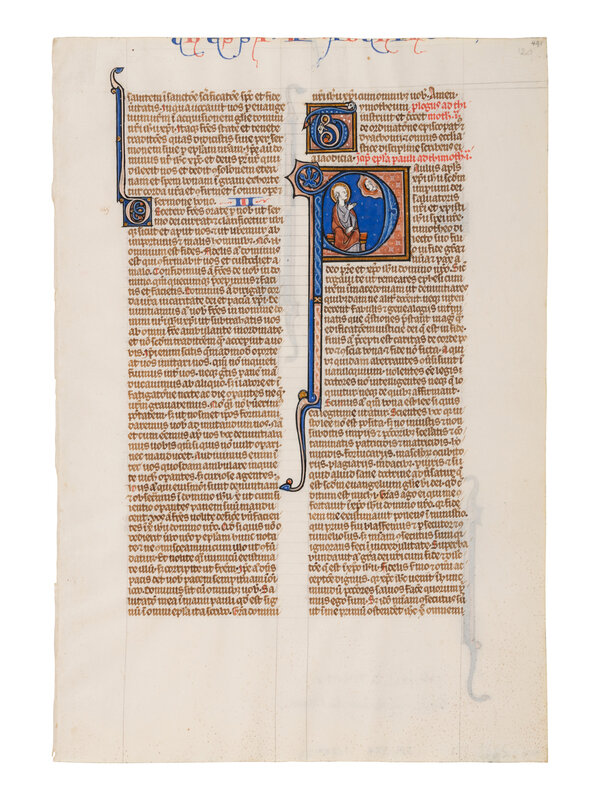DOMINICAN PAINTER? (active Paris, mid-13th century)
A leaf from the Chester Beatty Bible, with a historiated initial ‘P’ of God appearing to St. Paul, in Latin, illuminated manuscript on parchment (France, Paris, c. 1250-1275)
A leaf from the Chester Beatty Bible, with a historiated initial ‘P’ of God appearing to St. Paul, in Latin, illuminated manuscript on parchment (France, Paris, c. 1250-1275)
Sale 2033 - Western Manuscripts and Miniatures
Jun 27, 2024
10:00AM CT
Live / Chicago
Own a similar item?
Estimate
$2,000 -
3,000
Price Realized
$4,128
Sold prices are inclusive of Buyer’s Premium
Lot Description
DOMINICAN PAINTER? (active Paris, mid-13th century)
A leaf from the Chester Beatty Bible, with a historiated initial ‘P’ of God appearing to St. Paul, in Latin, illuminated manuscript on parchment (France, Paris, c. 1250-1275)
A leaf from the Chester Beatty Bible, with a historiated initial ‘P’ of God appearing to St. Paul, in Latin, illuminated manuscript on parchment (France, Paris, c. 1250-1275)
Traditionally attributed to the Dominican Painter, whom Branner calls “a rare and original painter” known for his deep rich colors and delicate stylized poses of the figures.
232 x 158 mm. Single leaf, modern foliation ‘129’ and ‘491’ in pencil in the top outer corner, ruled in brown ink for two columns of 51 lines (written space: 170 x 110 mm), written in light brown ink in a formal gothic book hand, versal initials touched with red, rubrics in red, running titles and chapter numbers alternately in red and blue, four three-lines illuminated initials in light brown and blue with burnished gold disks and white tracery, in-filled with hybrids, including three with marginal extensions alongside the column, one five-line illuminated initial in blue on light red ground, in-filled with hybrid and framed with gold, one TEN-LINE HISTORIATED INITIAL in blue on lapis blue and red checkered ground, framed with burnished gold ground, extending into the margin with compartments of the same and gold disks (running title trimmed at top, slight cockling in upper and lower margin, else in excellent condition).
This leaf comes from a splendid large thirteenth-century Bible that was once owned by Sir Alfred Chester Beatty (his W. MSS 116, see below). The double foliation indicates that the leaf was f. 491 in the parent manuscript, before most of the Old Testament leaves were removed, presumably by Léon Gruel, and subsequently became f. 129 when it was foliated anew by Eric Millar for Chester Beatty. This leaf contains parts of the Second Epistle of St. Paul to the Thessalonians and of the First Epistle of St. Paul to Timothy, reading on the recto from 2 Thessalonians 2:13, “salute in sanctificatione spiritus,” to 1 Timothy 4:12 on the verso, “Nemo adolescentiam tuam contemnat.” The Epistle of St. Paul to Timothy is introduced with a large historiated initial P, for “Paulus,” set on a ground of lapis blue highlighted with motifs of three white dots, that accompanies the text in a long stem descending in the inner margin. St. Paul appears seated in profile, raising his hand as he addresses God who appears to him from a cloud.
The luxurious nature of the commission is demonstrated by the illumination of each chapter initial in this leaf with color and gold, some even extending into the margin. These initials are distinctive for their crisp appearance, the relative lack of gold except for the outer frames and disks of the initials, the use of a ground pattern combining octagonal and square motifs, and a general restraint of the marginal extensions in the borders. Although the illumination of the Chester Beatty Bible had been localized in northern France and related to the Dominican Painter at the time of its sale, Peter Kidd has recently argued for an execution outside of Paris, considering both these stylistic peculiarities and the flaking of the brown ink.
Provenance
(1) Charles Edwin Puckett, Ohio, as suggested by the inventory number IM-324 written in pencil the lower margin of the recto.
(2) Kenneth W. Rendell, Massachusetts.
Parent manuscript
1. The parent manuscript consisted of 549 leaves in the early twentieth century, with no earlier provenance recorded.
2. It belonged to Léon Gruel (1841-1923) or his son (Paul), who most likely removed most of the Old Testament text leaves and rebound the remainder in blue velvet.
3. This remainder was acquired before 1930 by Sir Afred Chester Beatty (1875-1968), foliated anew by Eric Millar for his intended catalogue, and exhibited at Trinity College in Dublin in 1955.
4. The manuscript was auctioned at his posthumous sale at Sotheby’s, London, 3 December 1968, lot 14, only preserving then 187 leaves.
5. Acquired by Alan Thomas and Charles Ede of Folio Fine Art, and subsequently dismembered.
Sister leaves
Sister leaves are found in public collections in Amsterdam, Rijksmuseum (RP-T-1969:221), Boston, Public Library (MS q Med. 275), Dublin, Chester Beatty Library (W 116, f. 54), and Notre Dame (IN), Snite Museum (Acc. 1989.20.3) and Hesburgh Library (Frag. I. 34).
For a recent list of sixty-one sister leaves with and without historiated initials, see Kidd 2021, no. 37, pp. 141-117 (the present leaf unknown to him).
LITERATURE
On the parent manuscript and sister leaves, published: R. O. Dougan, A Loan Collection of Western Illuminated Manuscripts from the Library of Sir Chester Beatty, Dublin, 1955, no. 10; Sotheby’s, London, 3 December 1968, lot 14; The Rendells Inc., Catalogue 146: The Medieval World, 800 AD – 1450 AD, Newton, 1979, no. 26; Peter Kidd, The McCarthy Collection. French Miniatures, London, 2021, no. 37, pp. 141-146 (with further literature); further reading, Robert Branner, Manuscript Painting in Paris during the Reign of Saint Louis, Berkeley, CA, 1977. Freeman’s | Hindman thank Senior Consultant Sandra Hindman and Elliott Adam for their assistance in preparing this sale.
The Collection of Kenneth W. Rendell
Condition Report
Contact Information

